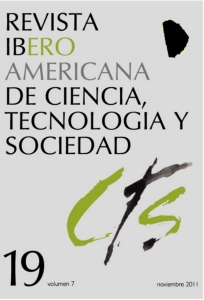Theories of Cyborg
the machinic and the human in Stanislaw Lem and Donna Haraway
DOI:
https://doi.org/10.52712/issn.1850-0013-735Keywords:
cyborg, Donna Haraway, Stanislaw LemAbstract
This conference aims to establish contrasts between the conceptions of cyborgs in Stanislaw Lem’s Summa Technologiae (1960) and in Donna Haraway’s A Cyborg Manifesto (1985). We argue that Haraway’s cyborg is a response to the context of American political activism, in which bipolarizations predominate and where a subject of multiple identities acquires a subversive character and a disruptive symbolic potential. On the contrary, Lem’s cyborg is built as a real possibility, the result of an extrapolation of the underlying logic of the evolutionary process. It represents an uninflected moment since, still attached to the underlying logic, men would find themselves forced to reverse it through drastic somatic changes in human bodies. The contradictions between the two definitions open a list of philosophical, technical and moral problems that we want to discuss.
Downloads
References
DELEUZE, G. e PARNET, C. (2004): Diálogos, Lisboa, Relógio D’Água.
DUTRA, R. A. (2005): O Desencantamento das Ciências, São Paulo, Tese de Doutorado, PUC.
DUTRA, R. A. (2007): “As Tecnociências, a História da SPBC e a Estruturação do Sistema Institucionalizado de Produção de Conhecimento (SIPC)”, Anais do II Simpósio Nacional de Tecnologia e Sociedade, Curitiba, UTFPR.
DUTRA, R. A. (2009): “Tecnociências e Burocracia: a Hierarquia das Impessoalidades”, Anais do III Simpósio Nacional de Tecnologia e Sociedade, Curitiba.
ELIAS, N. (2009): Essays I: On the Sociology on the Knowledge and the Sciences, Dublin, UCD.
GALIMBERTI, U. (2006): Psiche e Techne, São Paulo, Paulus.
GEHLEN, A. (s.d.): A Alma na Era da Técnica, Lisboa, Livros do Brasil.
GEHLEN, A. (1984): Moral e Hipermoral, Rio de Janeiro,Tempo Brasileiro.
HARAWAY, D. (2000): “Manifesto Ciborgue: ciência, tecnologia e feminismo-socialista no final do século XX”, em T. T. Silva: Antropologia do ciborgue: as vertigens do pos-humano, Belo Horizonte, Autêntica.
KO_AKOWSKI, L. (2008): Main currents of Marxism, Nova Iorque, W. W. Norton.
KUBRICK, S. (1969): 2001 - A Space Odissey.
KURZWEIL, R. (1999): The Age of Spiritual Machines, Nova Iorque, Penguin Viking.
LEM, S. (1960): Summa Technologiae.
LEM, S. e SWIRSKI, P. (1997): A Stanislaw Lem reader, Evanston Ill, Northwestern University Press,
MARTINS, H. (1996): Hegel, Texas e outros Ensaios de Teoria Social, Lisboa, Século XXI.
MARTINS, H. (1998): “O deus dos artefatos - sua vida, sua morte”, em H. R. de Araujo (org.): Tecnociência e Cultura, São Paulo, Estação Liberdade.
MARTINS, H. (2001): “Dois princípios filosóficos e a técnica: I. O Princípio da Plenitude; II. O Princípio de Vico”, Cadernos do CECL, Lisboa, CECL.
MARTINS, H. (2001-c): “Goodbye Body - momenta of discarnation in technoscience today”, em J. Urbano e D. Guarda (orgs.): Body Fast Forward/Corpo Fast Forward, Lisboa, Opium e Arte.
MARTINS, H. (2002): “A singularidade está próxima - prepare to meet thy doom!”, em J. B. de Bragança e M. T. Cruz (orgs.): Crítica das Ligações na Era da Técnica, Lisboa, Tropismos.
PINTO, Á. V. (1969): Ciência e Existência, Rio de Janeiro, Paz e Terra.
PINTO, Á. V. (2005): O Conceito de Tecnologia, Rio de Janeiro, Contraponto.
SAHLINS, M. (2004): Esperando Foucault, ainda, Sa_o Paulo, Cosac Naify.
SANDBERG, A. e BOSTROM, N. (2008): “Whole Brain Emulation: a Roadmap”,
Technical Report #2008-3, Oxford, Oxford University/Future of Humanity Institute.
SCHELER, M. (2008): A Situação do Homem no Cosmos, Lisboa, Edições Texto & Grafia.
SCHRÖDINGER, E. (1997): O que é vida?, São Paulo, Editora da UNESP.
SEVERINO, E. (1984): A Filosofia Moderna, Lisboa, Edições 70.
SEVERINO, E. (1987): A Filosofia Contemporânea, Lisboa, Edições 70.
TIBBON-CORNILLOT, M. (1997): Os Corpos Transfigurados: mecanização do vivo e imaginário da biologia, Lisboa, Instituto Piaget.
VOEGELIN, E. (2009): Ordem e História - O Mundo da Pólis, São Paulo, Edições Loyola
Downloads
Published
How to Cite
Issue
Section
License
Copyright (c) 2024 CC Attribution 4.0

This work is licensed under a Creative Commons Attribution 4.0 International License.
All CTS's issues and academic articles are under a CC-BY license.
Since 2007, CTS has provided open and free access to all its contents, including the complete archive of its quarterly edition and the different products presented in its electronic platform. This decision is based on the belief that offering free access to published materials helps to build a greater and better exchange of knowledge.
In turn, for the quarterly edition, CTS allows institutional and thematic repositories, as well as personal web pages, to self-archive articles in their post-print or editorial version, immediately after the publication of the final version of each issue and under the condition that a link to the original source will be incorporated into the self-archive.











